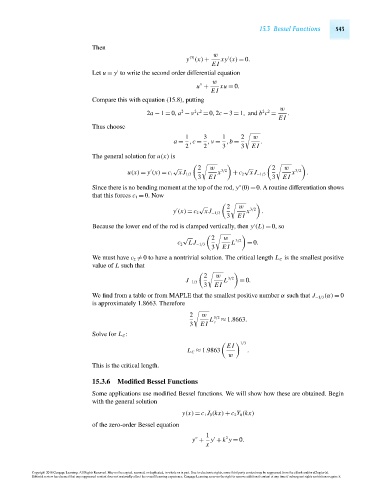Page 563 - Advanced_Engineering_Mathematics o'neil
P. 563
15.3 Bessel Functions 543
Then
w
(3)
y (x) + xy (x) = 0.
EI
Let u = y to write the second order differential equation
w
u + xu = 0.
EI
Compare this with equation (15.8), putting
w
2 2 2 2 2
2a − 1 = 0,a − ν c = 0,2c − 3 = 1, and b c = .
EI
Thus choose
1 3 1 2 w
a = ,c = ,ν = ,b = .
2 2 3 3 EI
The general solution for u(x) is
√ 2 w √ 2 w
3/2 3/2
u(x) = y (x) = c 1 xJ 1/3 x + c 2 xJ −1/3 x .
3 EI 3 EI
Since there is no bending moment at the top of the rod, y (0)=0. A routine differentiation shows
that this forces c 1 = 0. Now
√ 2 w
3/2
y (x) = c 2 xJ −1/3 x .
3 EI
Because the lower end of the rod is clamped vertically, then y (L) = 0, so
√ 2 w
L 3/2 = 0.
c 2 LJ −1/3
3 EI
We must have c 2 = 0 to have a nontrivial solution. The critical length L C is the smallest positive
value of L such that
2 w 3/2
J −1/3 L = 0.
3 EI
We find from a table or from MAPLE that the smallest positive number α such that J −1/3 (α) = 0
is approximately 1.8663. Therefore
2 w
L 3/2 ≈ 1.8663.
3 EI c
Solve for L C :
1/3
EI
L C ≈ 1.9863 .
w
This is the critical length.
15.3.6 Modified Bessel Functions
Some applications use modified Bessel functions. We will show how these are obtained. Begin
with the general solution
y(x) = c 1 J 0 (kx) + c 2 Y 0 (kx)
of the zero-order Bessel equation
1
2
y + y + k y = 0.
x
Copyright 2010 Cengage Learning. All Rights Reserved. May not be copied, scanned, or duplicated, in whole or in part. Due to electronic rights, some third party content may be suppressed from the eBook and/or eChapter(s).
Editorial review has deemed that any suppressed content does not materially affect the overall learning experience. Cengage Learning reserves the right to remove additional content at any time if subsequent rights restrictions require it.
October 14, 2010 15:20 THM/NEIL Page-543 27410_15_ch15_p505-562

